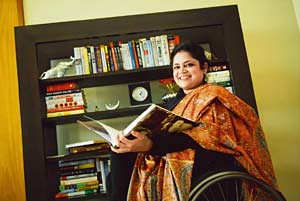You can’t expect the managing director of Jindal SAW Ltd to be made of anything less than steel. And Sminu Jindal shows Herculean strength because after altering the face of Qutab Minar and Red Fort in New Delhi, she will assist the Dalai Lama in making his temple in Dharamsala accessible to physically challenged people. Jindal, who became wheelchair-bound after an accident at the age of 11, also runs the non-profit organization Swayam to make the city accessible. She talks about the daily barriers in the life of a physically challenged person when he or she is going into the workplace. Edited excerpts from an interview:
Do you feel the Indian workplace is sensitized to the needs of the differently abled?
Paving the way: The workplace is far from being sensitized, says Jindal.
 It is far from being sensitized. In fact, the problem starts even before the workplace, it happens at the time we’re getting educated. If you aren’t going to make education accessible to (differently abled) youngsters, how will they get the skill or training to even be employable? When I was about to join college, my father had to get a slope constructed at SRCC (Shri Ram College of Commerce) because there was none. This was possible because we could afford it, but what about the ones who can’t? It just means they will be denied education. There’s no point having 10% reservation for the differently abled if they can’t access their colleges in the first place.
It is far from being sensitized. In fact, the problem starts even before the workplace, it happens at the time we’re getting educated. If you aren’t going to make education accessible to (differently abled) youngsters, how will they get the skill or training to even be employable? When I was about to join college, my father had to get a slope constructed at SRCC (Shri Ram College of Commerce) because there was none. This was possible because we could afford it, but what about the ones who can’t? It just means they will be denied education. There’s no point having 10% reservation for the differently abled if they can’t access their colleges in the first place.
What are the most basic barriers a differently abled person faces in accessing his/her office?
The physical infrastructure in our country does not cater to the needs of a physically challenged person. For a person to go to work means their mother/father/family member has to leave their job and assist them the whole day, taking them in and out of wheelchairs, etc. Restrooms are not accessible, that is, they are too small and leave no room for wheelchairs, or there are steps, and level changes, and places that have ramps often have very steep gradients, which can be very hazardous.
But in addition to the internal access within the workplace, what also matters is being able to access your workplace in the first place. The basic infrastructure is so poor that there was no way these people could even come in to work.
What are the most basic facilities a workplace must ensure for differently abled employees?
First, make level changes accessible by having elevators and ramps. Ramps must be the 1:12 gradient. Doors should be wider, about 3ft. Every floor should have a restroom that is accessible. Restrooms should also be accessible, that is, they should have space for a wheelchair; wherever required, there should also be railings for support. And yes, at least make sure your employee can get to his workstation without assistance.
Your organization has worked to make the Qutab Minar and Red Fort accessible. Could you tell us about this process?
When Stephen Hawkins came to India in 2000, the inaccessible infrastructure became glaringly evident. It was then that we started getting involved to make these structures accessible. We added an accessible restroom to Qutab Minar. The Red Fort is now accessible all the way to the Diwan-i-Khas, which I had never seen until then.
What’s the biggest hurdle in providing access in this country? Is it lack of resources?
It is essentially the mindset. It’s almost as if because we have an enormous population, we seem to value human life less. In the West, you see how every person is valued, treated as a resource and asset to the economy. Here, being disabled means being subjected to house arrest. People too can be very insensitive to the disabled. As I child, I recall a particular incident that made me vow never to step outside my home: I was alone on a sidewalk and my wheelchair almost toppled into a manhole, the wheels had got stuck with the edge of the hole. Nobody helped me out, they formed a circle around me, to watch. Unless the mindset changes, the infrastructure can’t.
Interview : Shreya Ray from livemint.